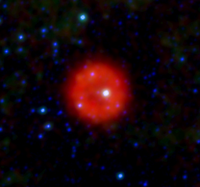SN 1181
| 超新星SN 1181 | |
|---|---|
| Pa 30 cropped (SII) cleaned up.jpg Pa 30是SN 1181的超新星遺跡。在這裡,星雲被看作是從中心恒星輻射出來的細長細絲。 | |
| 觀測資料 (曆元 J2000) | |
| 宿主星系 | 銀河系 |
| 星座 | 仙后座 |
| 赤經 | 00h 53m 11.2s |
| 赤緯 | +67° 30′ 02.4″ |
| 發現日期 | 1181年8月4日至8月6日 |
| 峰值星等 (V) | 0? |
| 物理性質 | |
| 值得注意的特色 | 夜間可見185天 |
| 其它超新星 | |
| Preceded by | SN 1054 |
| Succeeded by | SN 1572 |
SN 1181超新星是中國和日本天文學家在1181年8月4日至8月6日首次觀測到,之後被記錄在八個不同的文件中。
在有望遠鏡之前的記錄中,銀河系中只有五顆超新星被毫無疑義地識別出來[1],它出現在星座仙后座,它在恆星的映襯下動都不動地,在長達185天的夜晚時間裏都能夠看見。F.理查德·史蒂芬森首先體認到西元1181年的這顆客星一定是一顆超新星,因為這種持續185天且在天空中不移動的明亮瞬變,只能是星系中的超新星[2]。
Pa 30
[编辑]
Pa 30是由業餘天文學家達納·帕契克於2013年在WISE的紅外數據中尋找行星狀星雲時發現的[4]。 這是他蒐索發現的第30個星雲,因此被命名為Pa 30。Pa 30看起來是一個接近圓形的星雲,大小約為171x156弧秒,中心有一顆非常藍的恆星。Pa 30既指星雲(最初編目為IRAS 00500+6713),也指中心的恆星(名稱為WD J005311)。外殼在紅外波段很亮,但在光學的波段非常微弱,起初只能通過[O III]波段的光看到。
在2019年,經由光譜揭示了其中心有一顆非常熱的恆星,其强烈的恆星風以16,000公里/秒的極高速度膨脹,主要由碳、氧和氖組成(不含氫或氦)[5]。這樣的速度只能來自超新星或類似大小的事件,更具體地說,來自兩顆白矮星的合併。X射線光譜學對外殼的研究還揭示了一個非常熱的星雲,其中含有只能在超新星中產生的碳燃燒灰燼[6]。 然而,Pa 30的殘骸是一顆白矮星,而不是傳統的超新星殘骸(中子星或黑洞)。有人認為,Pa 30是一類罕見的超新星的殘骸,稱為「次光度Iax型超新星」,是碳-氧白矮星和氧-氖白矮星的合併產生了殘骸的外殼及超大質量白矮星殘骸。最近在[SII]波段的觀測也揭示了殼內以前從未見過的精細絲狀結構[7][8]。
2021年的一項研究通過[S II]雙峰光譜量測了星雲的膨脹速度約為1,100公里/秒;加上Pa 30的角尺寸和2.3 kpc的蓋亞距離,估計星雲的年齡約為1,000年。這使得Pa 30成為SN 1181事件遺跡的新主要候選者[9]。 此外,星雲的膨脹速度和1181事件的推斷絕對亮度與Iax型超新星一致,使Pa 30成為我們銀河系中唯一的SN Iax遺跡,也是唯一可以詳細研究的遺跡。
溫度接近200,000 K[5]的WD J005311是已知最熱的恆星之一 [10]。中心恆星的極端性質是由56Ni的殘餘放射性衰變提供動力的,由於鎳被完全電離,使得通常為6.0天的半衰期因為電子捕獲後增加到幾個世紀[11]。
3C 58
[编辑]在2013年之前,這顆超新星出現的區域中,在舊有歷史中唯一可能的常規超新星遺跡是3C 58。這個殘骸有一顆無線電和X射線脈衝星,每秒旋轉約15次。因此,儘管許多研究人員指出這種聯系是有問題的,從歷史上看,SN 1181與3C 58及其脈衝星有關。例如,如果超新星和脈衝星相關聯,那麼脈衝星的旋轉速度應該仍然和它最初形成時一樣快[12]。這與已知是1054年超新星SN 1054殘骸的蟹狀星雲脈衝星形成鮮明對比,後者在基本相同的時間跨度內損失了三分之二的旋轉動能[13]。
3C 58殘骸的年齡已通過多種方法估算[14] [15]。 最直接的是,3C 58膨脹殼的自行已經被量測了三次,得出與距離無關的估計年齡約為3,500年。射電通量下降率的量測具有很大的可變性和不確定性,因此它們對估算殘骸的年齡沒有幫助。由於距離以及假定的能量和密度存在很大的不確定性,涉及殘骸能量和掃掠質量的年齡估計也都是無用的。脈衝星偏離了3C 58的中心,這意味著它的年齡約為3,700年,而如果它的橫向速度很高,它可能會年輕得多。脈衝星的自旋減慢年齡為5,380年。中子星冷卻年齡>5000年。根據這些年齡估計,3C 58的年齡太大,無法與SN 1181聯系起來。
1181超新星在天空的位置可能已經被修訂過,以包括有關「客星」與相鄰中國星官接近程度的額外資訊,從而使原區域誤差得以減少[16]。這個改進的區域不包含3C 58,因為客星並不像報導的那樣靠近華蓋和王良這兩個中國的星官。所以,SN 1181與3C 58沒有關聯。相對的,這個新的小區域包含Pa 30,據獨立報導,它是一顆約800年前的超新星遺跡。
圖集
[编辑]-
WISE所呈現的Pa 30
-
Pa 30及其周边星云的假色图像
相關條目
[编辑]參考資料
[编辑]- ^ Stephenson, F. Richard; Green, David. Historical Supernovae and their Remnants. Clarendon Press. 2002. ISBN 0-19-850766-6.
- ^ Stephenson, F. Richard. A Suspected Supernova in A. D. 1181. Quarterly Journal of the Royal Astronomical Society. 1971, 12: 10–38. Bibcode:1971QJRAS..12...10S.
- ^ Ko, Takatoshi; Suzuki, Hiromasa; Kashiyama, Kazumi; Uchida, Hiroyuki; Tanaka, Takaaki; Tsuna, Daichi; Fujisawa, Kotaro; Bamba, Aya; Shigeyama, Toshikazu. A Dynamical Model for IRAS 00500+6713: The Remnant of a Type Iax Supernova SN 1181 Hosting a Double Degenerate Merger Product WD J005311. The Astrophysical Journal. 1 July 2024, 969 (2): 116. Bibcode:2024ApJ...969..116K. arXiv:2304.14669
 . doi:10.3847/1538-4357/ad4d99
. doi:10.3847/1538-4357/ad4d99  .
.
- ^ Kronberger, M.; et al. New Planetary Nebulae and Candidates from Multicolour Multiwavelength Surveys (PDF). Asymmetrical Planetary Nebulae VI conference. 2014.
- ^ 5.0 5.1 Gvaramadze, Vasilii V.; et al. A massive white-dwarf merger product before final collapse. Nature. 2019, 569 (7758): 684–687. Bibcode:2019Natur.569..684G. PMID 31110332. S2CID 90260784. arXiv:1904.00012
 . doi:10.1038/s41586-019-1216-1.
. doi:10.1038/s41586-019-1216-1.
- ^ Oskinova, Lidia M.; et al. X-rays observations of a super-Chandrasekhar object reveal an ONe and a CO white dwarf merger product embedded in a putative SN Iax remnant. Astronomy & Astrophysics. 2020, 644: L8. Bibcode:2020A&A...644L...8O. S2CID 221293111. arXiv:2008.10612
 . doi:10.1051/0004-6361/202039232.
. doi:10.1051/0004-6361/202039232.
- ^ Hall, Shannon. Weird supernova remnant blows scientists' minds. Nature. 2023-01-26, 614 (7947): 206. Bibcode:2023Natur.614..206H. PMID 36702966. doi:10.1038/d41586-023-00202-1
 (英语).
(英语).
- ^ Fesen, Robert A.; Schaefer, Bradley E.; Patchick, Dana. Discovery of an Exceptional Optical Nebulosity in the Suspected Galactic SN Iax Remnant Pa 30 Linked to the Historical Guest Star of 1181 CE. The Astrophysical Journal Letters. 2023-01-11, 945 (1): L4. Bibcode:2023ApJ...945L...4F. arXiv:2301.04809
 . doi:10.3847/2041-8213/acbb67
. doi:10.3847/2041-8213/acbb67  .
.
- ^ Ritter, Andreas; et al. The Remnant and Origin of the Historical Supernova 1181 AD. The Astrophysical Journal Letters. 2021, 918 (2): L33. Bibcode:2021ApJ...918L..33R. arXiv:2105.12384
 . doi:10.3847/2041-8213/ac2253
. doi:10.3847/2041-8213/ac2253  .
.
- ^ Ouellette, Jennifer. Astronomers solve centuries-old mystery of supernova observed in 1181. arstechnica.com. 17 September 2017 [21 August 2024].
- ^ Shen, Ken J.; Schwab, Josiah. Wait for it: Post-supernova Winds Driven by Delayed Radioactive Decays. The Astrophysical Journal. 2017, 834 (2): 180. Bibcode:2017ApJ...834..180S. arXiv:1610.06573
 . doi:10.3847/1538-4357/834/2/180
. doi:10.3847/1538-4357/834/2/180  .
.
- ^ Panagia, N.; Weiler, K. W. The absolute magnitude and the type classification of SN 1181 equals 3 C 58. Astronomy and Astrophysics. 1980, 82 (3): 389–391. Bibcode:1980A&A....82..389P.
- ^ Galas, C. M. F.; Tuohy, I. R.; Garmire, G. P. Soft X-ray observations of the supernova remnants HB 3 and 3C 58. The Astrophysical Journal Letters. 1980, 236: L13–L16. Bibcode:1980ApJ...236L..13G. doi:10.1086/183188.
- ^ Fesen, Robert; Rudie, Gwen; Hurford, Alan; Soto, Aljeandro. Optical Imaging and Spectroscopy of the Galactic Supernova Remnant 3C 58 (G130.7+3.1). The Astrophysical Journal Supplement Series. 2008, 174 (2): 379–395. Bibcode:2008ApJS..174..379F. S2CID 120672848. doi:10.1086/522781
 .
.
- ^ Kothes, A. Distance and age of the pulsar wind nebula 3C 58. Astronomy and Astrophysics. 2013, 560: A18. Bibcode:2013A&A...560A..18K. S2CID 118595074. arXiv:1307.8384
 . doi:10.1051/0004-6361/201219839.
. doi:10.1051/0004-6361/201219839.
- ^ 16.0 16.1 Schaefer, Bradley E. The path from the Chinese and Japanese observations of supernova 1181 AD, to a Type Iax supernova, to the merger of CO and ONe white dwarfs. Monthly Notices of the Royal Astronomical Society. 2023-08-01, 523 (3): 3885–3904. Bibcode:2023MNRAS.523.3885S. ISSN 0035-8711. arXiv:2301.04807
 . doi:10.1093/mnras/stad717
. doi:10.1093/mnras/stad717  .
.

![2023年,布蘭得利·捨費爾(英语:Bradley Schaefer)根據古代中國和日本的觀測,對SN 1181的約束條件(青色區域),以及3C 58和Pa 30的位置[16]。](http://upload.wikimedia.org/wikipedia/commons/thumb/8/8a/SN_1181_-_Schaefer_2023_Figure_5.png/200px-SN_1181_-_Schaefer_2023_Figure_5.png)



